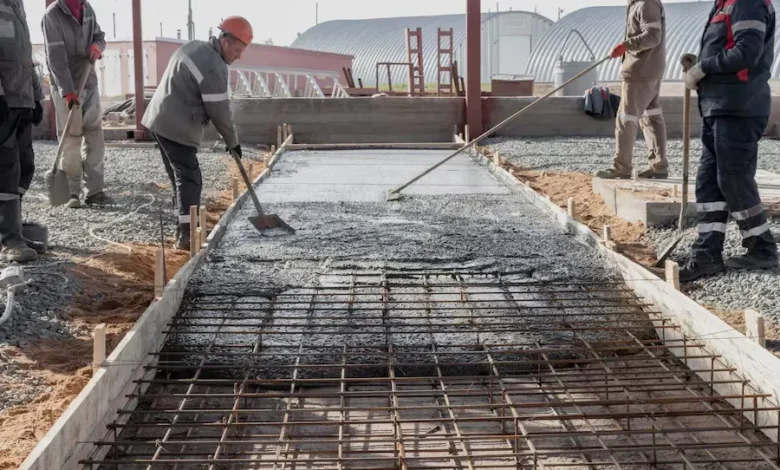Why Concrete Remains the Cornerstone of Modern Construction

Concrete underpins nearly every aspect of modern infrastructure—from the foundations beneath our homes to the highways and bridges we rely on each day. Its origins stretch back thousands of years, but continued innovation ensures it remains a vital force in today’s construction industry. Durable, adaptable, and engineered for long-term performance, concrete is more than just a building material—it’s an essential tool for shaping the future of design and development.
In this in-depth article, we will explore what makes concrete such a vital building material, how it’s used across various sectors, the technological innovations shaping its future, and why working with expert providers like Bison Concrete is essential to achieving excellence in any concrete-based project.
What Is Concrete?
Concrete is a composite construction material made from a mixture of cement, water, and aggregates such as sand, gravel, or crushed stone. Once mixed, it undergoes a chemical reaction known as hydration, hardening over time into a rock-like material with remarkable strength and durability.
Although simple in composition, concrete’s performance depends heavily on the precise balance of its ingredients, the method of mixing, and environmental conditions during curing. It’s one of the few materials that can be poured into virtually any shape, customized in color and texture, and scaled for use in projects of any size—from patios to skyscrapers.
The Ubiquity and Versatility of Concrete
The true power of concrete lies in its versatility. Its applications span across residential, commercial, and industrial sectors, making it an essential material for:
- Foundations and Structural Support
Concrete forms the foundation of most buildings, providing stability and load-bearing strength. Whether it’s a single-story home or a multi-level commercial complex, concrete footings and slabs are crucial to the integrity of the structure. - Roadways and Transportation
From highways and airport runways to tunnels and bridges, concrete plays a critical role in transportation infrastructure. Its durability and resistance to weathering make it ideal for high-traffic surfaces. - Sidewalks and Curbs
Urban environments rely on concrete for pedestrian walkways, curbs, gutters, and accessibility ramps, offering a smooth and long-lasting surface. - Retaining Walls and Landscaping
Concrete blocks and poured systems are commonly used to create retaining walls, garden borders, and outdoor staircases. With decorative finishes, concrete can also serve an aesthetic function. - Industrial Floors and Warehouses
In factories and warehouses, concrete provides a strong, level surface that can withstand heavy machinery and constant use. - Decorative Concrete
Stained, stamped, or textured concrete allows for creative applications in patios, driveways, floors, countertops, and architectural features.
No matter the use case, professional craftsmanship ensures the success of each project. That’s why many builders and homeowners turn to experts like Bison Concrete, known for precision, reliability, and custom solutions.
Why Concrete Continues to Be the Material of Choice
Concrete continues to be one of the most widely used materials in the world due to a combination of structural benefits, environmental advantages, and long-term cost-efficiency.
Structural Advantages:
Concrete delivers unmatched durability and strength, with structures designed to last for decades. Its non-combustible nature makes it resistant to fire and weather damage, adding a layer of safety to any project. Once cured, it requires very little maintenance, making it a preferred material in both residential and commercial builds.
Energy and Environmental Benefits:
Concrete’s thermal mass helps regulate indoor temperatures, improving energy efficiency. Additionally, modern concrete formulations can include recycled materials and support water management through pervious surfaces.
Cost-Effectiveness:
With a long service life and minimal upkeep, concrete offers strong long-term ROI, making it an economical choice for large and small projects alike.
Innovations in Concrete Technology
While the base formula for concrete has remained largely the same for centuries, technology continues to push its capabilities forward.
- Self-Healing Concrete
Embedded microcapsules or bacteria are used to automatically seal cracks when moisture penetrates the surface, reducing the need for repairs. - Ultra-High-Performance Concrete (UHPC)
This material offers incredible strength and resilience, making it ideal for demanding projects like high-rise buildings and complex infrastructure. - 3D Printed Concrete
Robotic arms and custom nozzles now allow for entire structures to be printed layer by layer using specially formulated concrete, revolutionizing construction speed and precision. - Carbon-Reducing Concrete
Innovations aim to reduce the carbon footprint of cement production—a major contributor to global CO₂ emissions—by integrating alternative materials and energy-efficient manufacturing.
Top contractors like Bison Concrete stay at the forefront of these trends, applying the latest methods and materials to deliver performance-driven results.
Why Proper Installation Makes All the Difference
Despite its strength, concrete is highly sensitive to how it’s handled during mixing, pouring, and curing. Mistakes at any point in the process can result in cracking, scaling, or premature deterioration.
Hiring professional contractors ensures:
- Proper soil preparation and reinforcement
- Accurate mix design tailored to project conditions
- Correct timing and techniques for pouring and finishing
- Strategic placement of control joints to prevent cracks
- Professional sealing and curing for enhanced durability
Whether you’re laying a foundation or creating a decorative patio, partnering with seasoned experts like Bison Concrete guarantees that your concrete will meet structural and aesthetic standards for years to come.
The Rise of Decorative and Architectural Concrete
Concrete is no longer just a gray, flat surface. Advances in coloring, stamping, and finishing allow it to mimic other materials and integrate into modern architectural designs.
- Stamped Concrete
Popular in patios and walkways, this technique involves pressing patterns into the surface to resemble stone, brick, tile, or wood. - Stained Concrete
Acid-based or water-based stains give concrete vibrant colors and depth, making it a popular choice for indoor floors. - Exposed Aggregate
Exposed aggregate finishes are achieved by stripping away the top layer of cement paste, revealing decorative pebbles or crushed stone beneath. This technique adds texture and traction while offering a more natural aesthetic. It’s commonly used in driveways, sidewalks, and pool decks where both visual appeal and slip resistance are important. - Polished Concrete
Highly reflective and sleek, polished concrete is ideal for modern interiors, showrooms, and retail spaces.
These decorative options add value and personality to both residential and commercial properties, elevating concrete beyond functionality into the realm of artistry.
Sustainability and the Future of Concrete
As environmental concerns grow, the construction industry is increasingly focused on making concrete more sustainable.
Recycled Materials:
Using crushed concrete, glass, and slag reduces the need for virgin materials.
Carbon Capture:
Innovative technologies are being developed to trap CO₂ emissions during cement production.
Pervious Concrete:
Allows water to pass through, helping recharge groundwater and reduce runoff in urban areas.
Concrete’s adaptability makes it a crucial part of future-forward building strategies that emphasize environmental responsibility.
Keeping Concrete Strong for Decades
To extend the lifespan of concrete installations, follow these simple maintenance practices:
- Seal Surfaces: Reapply sealers every few years to protect against moisture, stains, and abrasion.
- Clean Regularly: Sweep and wash surfaces to remove dirt, mildew, and contaminants.
- Repair Early: Address cracks and chips promptly before they expand.
- Avoid Harsh Chemicals: Deicing salts and strong cleaners can damage the surface over time.
With routine care and quality installation, concrete can perform beautifully for decades.
Concrete’s Enduring Role in Modern Construction
Concrete is not just a building material—it’s a cornerstone of modern life. Its strength, adaptability, and cost-efficiency make it indispensable in nearly every sector of construction. As technologies evolve and sustainability becomes a greater priority, concrete continues to prove its relevance and versatility.
Whether you’re creating a commercial foundation, designing an artistic patio, or building an entire structure, the expertise behind the work is what ensures its success. Trusted providers like Bison Concrete bring a combination of technical know-how, craftsmanship, and innovation to every project, ensuring results that endure.
Choose your concrete partner wisely. With expert handling and thoughtful application, concrete can elevate any project—whether it’s a residential patio or a large-scale commercial foundation.
Business Name: Bison Concrete
Address: 5920 NW 56th St, Warr Acres, OK 73122
Phone number: (405) 881-8384




